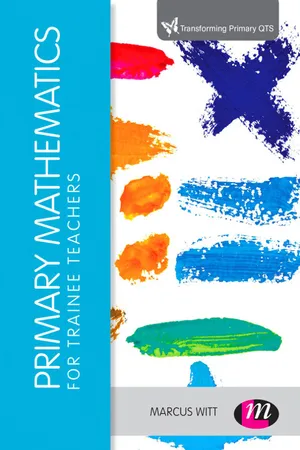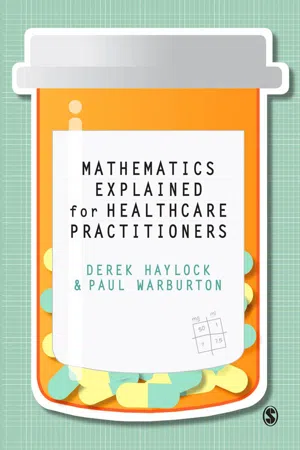Mathematics
Ratio Fractions
Ratio fractions are expressions that compare two quantities using a fraction format. They are used to represent the relationship between two numbers or quantities. In a ratio fraction, the numerator and denominator can both be whole numbers, and the ratio can be simplified to its simplest form.
Written by Perlego with AI-assistance
Related key terms
7 Key excerpts on "Ratio Fractions"
- eBook - ePub
Teaching Fractions and Ratios for Understanding
Essential Content Knowledge and Instructional Strategies for Teachers
- Susan J. Lamon(Author)
- 2020(Publication Date)
- Routledge(Publisher)
8 is not as important as the fact that a single relationship is conveyed. When we consider fractions as single numbers, rather than focusing on the two parts used to write the fraction symbol, the focus is on the relative amount conveyed by those symbols.Regardless of the size of the pieces, their color, their shape, their arrangement, or any other physical characteristic, the same relative amount and the same rational number is indicated in each picture. (Psychologically, for the purpose of instruction, when fractions are connected with pictorial representations, which fraction name you connect with which picture is an important issue. For example, you would not call the first picture2 8or4 16. )Fractions, Ratios, and Rates
A ratio is an ordered pair that conveys the relative sizes of two quantities. Under this definition, a part–whole fraction is a ratio; however, every ratio is not a part–whole comparison. A ratio may compare measures of two parts of the same set (a part–part comparison) or the measures of any two different quantities (e.g. cups of juice concentrate to cups of water). Often, ratios are expressed as “per” quantities. For example, miles per hour and candies per bag are both ratios or comparisons of unlike quantities.The ratio–rate distinction is a bit more complex. When we are discussing a very particular situation, we use a ratio. However, if that ratio is one that is extendible to a broader range of situations, it is a rate. - eBook - ePub
A Focus on Ratios and Proportions
Bringing Mathematics Education Research to the Classroom
- Marjorie M. Petit, Robert E. Laird, Matthew F. Wyneken, Frances R. Huntoon, Mary D. Abele-Austin, Jean D. Sequeira(Authors)
- 2020(Publication Date)
- Routledge(Publisher)
class .Unlike with ratios, switching the position of the numerator and denominator in a fraction results in a different number. For example,.3 4m i l e ≠4 3m i l eSometimes Ratios and Fractions Act in Similar Ways
Despite these general differences between fractions and ratios, there are times when these two interpretations ofa bact in similar ways and times when they act quite differently. This may be another reason students struggle with the differences between ratios and fractions. In some situations, for example, a part-to-whole ratio can meaningfully be interpreted as a fraction. One can restate the part-to-whole ratio example, as a fraction. That is, “4 r e d c h a i r s19 t o t a l c h a r s4 19of the chairs in the classroom are red.” In addition, we can use the same procedure to identify equivalent fractions and equivalent ratios. Figure 1.11 provides an example.Figure 1.11 Equivalent ratios and equivalent fractionsAlthough we use the same procedure, multiplying or dividing each quantity in a ratio or fraction by the same number, we interpret the meaning of these two situations differently. In the case of the ratio,is equivalent to12 students2 coachesbecause the multiplicative relationship between the quantities is the same in each ratio. That is, in each situation, there are 6 students for each coach. In the fraction example,24 students4 coaches3 4=6 8 - eBook - ePub
Fostering Children's Mathematical Power
An Investigative Approach To K-8 Mathematics Instruction
- Arthur Baroody, Arthur J. Baroody, Ronald T. Coslick(Authors)
- 1998(Publication Date)
- Routledge(Publisher)
Unlike fractions representing a part-of-a-whole meaning, ratios can also represent a relationship between (a) a whole and its part (whole-to-part ratios), (b) one part of a whole and another part of the whole (part-to-part ratios), and (c) two different quantities (rates). For example, the ratio of all Ms. Pines’ football players to those who got As in Question 1 of Probe 12.2 (page 12-7) could be represented by the whole-to-part ratio (as long as it is made clear that the fixed relationship is total number of football players to that part getting an A). The ratios of football players who got As to those who didn’t (Question 2 of Probe 12.2) can be represented by the part-to-part ratio. The ratio 3 pies for $5 (Question 3 of Probe 12.2) can be represented by the rate 3/$5. In each of these three examples, the fraction representing a ratio clearly imply something other than a part-to-whole relationship. Single-Number Examples. By convention, some ratios are reported as single numbers, not as fractions. For example, 50 miles per hour is expressed as 50 mph, not, and 24 miles to the gallon is represented as 24 mpg, not. (Note that in these examples, the 1 hour or 1 gallon is implied—much like the whole number 4 implies four wholes or. ) Various Representations. The ratio of one to two can be expressed as 1:2, (1,2), l→2, or 1 to 2 as well as in fraction form. Ratios with Zero. Whereas the common fraction is not possible because a whole cannot be divided into noneths, a ratio such as 9:0 or 9/0 is possible. It could represent, for instance, the number of starters on a major league baseball team making a million dollars a year compared to those making less than a million. Such applications are relatively rare but do imply that ratios are not necessarily rational numbers. Ratios with Nonrational Numbers. Ratios can involve nonrational numbers. For example, as you may have discovered in Investigation 12.2, the ratio of a square’s side and its diagonal is - eBook - ePub
- Marcus Witt(Author)
- 2014(Publication Date)
- Learning Matters(Publisher)
Part-whole fractions partition a continuous quantity or a set of discrete objects into a number of equal-sized parts. In this interpretation, the numerator must be smaller than the denominator, for example a pie is divided into four equal parts (quarters) and three are eaten, so ¾ of the pie has been eaten.When using the part-whole representation, children should understand that (a) the parts into which the whole is partitioned must be of equal size; (b) the parts, when taken together, must equal the whole; (c) the more parts the whole is divided into, the smaller the parts become; and (d) the relationship between the parts and the whole is conserved, regardless of the size, shape or orientation of the equivalent parts (Leung, 2009).Fractions as Quotient
The quotient interpretation is the result of a division. It results in a number that can be placed on a number line, for example . For this interpretation, children should be able to identify fractions using division and understand the role of the dividend and the divisor in this operation (Leung, 2009).Fractions as Measurement
In a measure interpretation a unit fraction is identified (for example, ¼) and the number of repeated units determine the distance from a predetermined starting point (for example, ).In this interpretation, children should be able to give a distance from the origin as a fraction. They should also be able to locate a fraction on a number line and identify a fraction represented by a point on the number line (Leung, 2009) or region (Pantziara and Philippou, 2012).Fractions as Ratio
A fraction can be seen as a ratio of two quantities; in this case it is seen as a part-part interpretation and it is considered to be a comparative index rather than a number (Carraher, 1996), for example three parts out of every four are red.For this interpretation, children need to understand the relative nature of the quantities. They also need to know that when two quantities in the ratio are multiplied by the same positive number the value of the ratio is unchanged (Leung, 2009). - Derek Haylock, Paul Warburton(Authors)
- 2013(Publication Date)
- SAGE Publications Ltd(Publisher)
UNDERSTANDING FRACTIONS AND RATIOS 11OBJECTIVES In everyday and healthcare contexts the practitioner should be able to:- interpret a fraction as a proportion of a whole unit or set
- recognize what must be added to a fraction to make 1
- interpret a fraction as the division of one number by another
- interpret a fraction as a ratio
- recognize equivalent fractions or equivalent ratios
- use cancelling to simplify a fraction or a ratio
- express a ratio as ‘one to something’ or ‘something to one’
- use mixed numbers
- state common equivalences between fractions and decimal numbers
- convert a fraction into a decimal number, or vice versa
- calculate a simple fraction of a number or quantity using informal mental, written or calculator methods
In this chapter our focus is on explaining the different concepts and principles involved in handling quantities expressed in fraction notation. To do this we use a mixture of everyday examples and some simple but occasionally rather artificial healthcare illustrations. In some cases we use results that turn up in the middle of the kinds of drug and infusion calculations that are explained in full in Chapter 12 . This is a long chapter, which for some readers may require persistence and concentration. But if you work hard at the content here you should emerge with a deeper understanding of some key concepts that will enable you to engage with the mathematical demands of healthcare practice with greater confidence.SPOT THE ERRORS Identify any obvious errors in the use of fraction notation in the following 15 statements.1 If a bar of chocolate is divided into 4 equal pieces and 3 of them are eaten then the amount eaten is ¾ of the bar. 2 If 3 bars of chocolate are shared equally between 4 people then each gets ¾ of a bar. 3 A patient’s dosage of Drug A is reduced from 4 mg to 3 mg each day. The new dose is ¾ of the original dose. - eBook - ePub
Teaching Mathematics in Primary Schools
Principles for effective practice
- Robyn Jorgensen(Author)
- 2020(Publication Date)
- Routledge(Publisher)
- Make a mix for a party of 24 children. How much of each mixer do you need?
In a mathematical sense, the different dimensions of ratio understanding promoted through mixing activities relate to:- ratio equivalence (e.g. 1:3 = 2:6)
- part-to-part and the multiplicative structure of ratio
- part-to-part and the relationship to the whole.
In early ratio investigations, the teacher's role is to engage students in discussion, problem-solving and reasoning in a guided sense. Through such explorations, the students can explore the sophisticated topic of ratio and develop proportional reasoning skills through discussion, hypothesising and justification without using mathematical symbolism.Identifying ratio and non-ratio situations
A further dimension to developing students' knowledge of ratio and proportion is to assist them in distinguishing situations that are proportional and those that are not. There are instances in which situations sound as if they are proportional and yet are not; and, conversely, situations that sound as if they are not proportional and yet are. Students' capacity to make these distinctions is a measure of the sophistication of their proportional reasoning (Van Dooren et al. 2005). For example, if five children sing a song that lasts two minutes, will they sing twice as fast if there are 10 children? If there are seven items of clothing on the line, will the clothes take longer to dry if there are 14 items of clothing? If two cars are racing around a track at the same speed, and the second car starts at the point at which the first car had completed three laps, will the first car have completed 12 laps after the second car has travelled four laps? All these situations sound as if they are proportional, yet they are not. Presenting proportional and non-proportional situations to students creates interesting discussion and promotes students' proportional reasoning development.Proportional reasoning and numeracy
Many everyday situations and decisions require proportional reasoning. When you are putting detergent into the washing machine, you may use the recommended amount, or you may make a decision dependent on how dirty your clothes are or how fresh you want them to smell. When you are driving in your car and see that your fuel gauge is heading towards empty, you make a decision about when to fill up, how far you have to travel, and how far away is the next fuel station. Because of the real-world nature of so many situations that require proportional reasoning, Dole and colleagues (2015; 2018) contend that proportional reasoning is an essential component of numeracy. Their research shows the value of immersing children in discussions about proportional reasoning that is evident in nature and in other authentic situations (Hilton et al. 2015)—for example, images of large flocks of birds at a lake, big and small animals at a watering hole, or a small bird struggling with a large fish in its mouth. Encouraging students to take photographs of images that require and depict proportional reasoning, such as standing next to a lamp post (how many times taller is the post than the person?) or a carpark full of cars (how many silver cars are there compared to red cars?) fosters and builds awareness of proportional reasoning in the real world. - eBook - ePub
- Sandra Rush(Author)
- 2017(Publication Date)
- Research & Education Association(Publisher)
yard more.d.$3.00. At $36 per yard, this cost would be . Another way to calculate this is to find the cost of yards ($36 × 11), or $396, and subtract the cost of yards from part (b): $396 – $393 = $3.Ratios and Proportions
A ratio is simply a way of comparing two numbers or expressing the relation between two quantities. A ratio can be expressed as a fraction or a decimal, and often is written with a colon between the numbers. For example, a small company employs 3 men and 7 women. Then we can say the ratio of men to women in that company is 3:7, or , both read as “3 to 7” because we are stating a ratio. We can even say there is .4286 of a man for each 1 woman, by dividing 7 into 3, although this is a little awkward to visualize.As another example, if the results of an election are a landslide in which one candidate received 5 times the number of votes of the other candidate, the ratio of votes is 1:5. However, the fractions of the votes received by the candidates are and (not for the losing candidate, as you might think). The ratio is 1:5, so the whole must be the sum, or 1 + 5 = 6.A proportion is the way to express that two ratios are equal. Again, the most common ways to write a proportion are with colons (3:7 = 6:14) or fractions , which is said as “3 is to 7 as 6 is to 14.” We will see proportions again in Chapter 4 , where we discuss solutions to algebra problems such as “If the ratio of men to women in the workplace is 3 to 7, how many men are in an office with 70 women?” Maybe you figured that out already. The ratio is , which is the same as , so for 70 women, there are 30 men. If you didn’t see this right away, it’s okay—this solution actually involves algebra.Two-thirds of a Spanish class have never studied Spanish before. In a class of 30 students, what is the ratio of those who have studied Spanish to those who haven’t?Example 2.8.Answer 2.8.1:2. Be careful to keep the numbers straight in this problem. For the number who have never studied Spanish before, it is
Learn about this page
Index pages curate the most relevant extracts from our library of academic textbooks. They’ve been created using an in-house natural language model (NLM), each adding context and meaning to key research topics.






